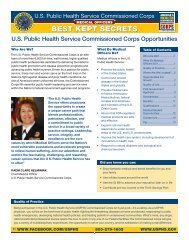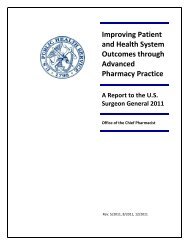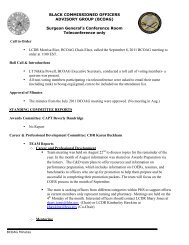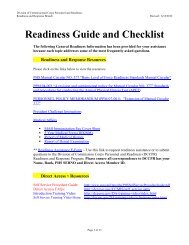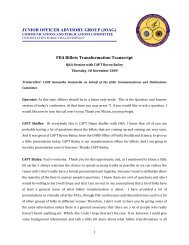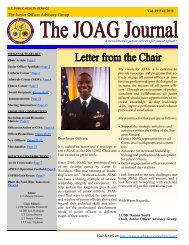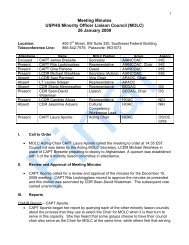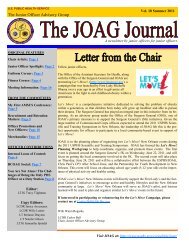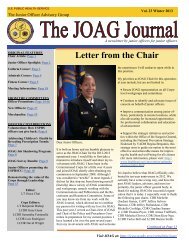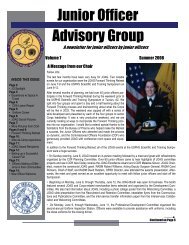Vol. 17 Winter - U.S. Public Health Service Commissioned Corps
Vol. 17 Winter - U.S. Public Health Service Commissioned Corps
Vol. 17 Winter - U.S. Public Health Service Commissioned Corps
You also want an ePaper? Increase the reach of your titles
YUMPU automatically turns print PDFs into web optimized ePapers that Google loves.
The JOAG JournalPage 6National Honor Flight Program: A Soldier’s StoryContributed by CDR Blakeley (Denkinger) Fitzpatrick*on behalf of the Inter-<strong>Service</strong>s Collaboration Committee, Community <strong>Service</strong> SubcommitteeI have always had a great appreciation for the men andwomen who have fought since the birth of our nation for thefreedom of all Americans. The events of the second WorldWar always seemed so distant and surreal when I read aboutthe war in history books or saw footage on TV, but then I meta piece of living history. Little did I know that when I volunteeredto provide assistance to veterans visiting the WWIImonument through Honor Flight that I would meet a newfriend for life.We were taking pictures, pushing veterans in wheelchairs, andlistening to recounts of war stories throughout the morningwhen a busload of veterans from Ohio pulled up. DonaldCurfman was one of the first veterans to step off the bus. Ioffered to take a picture of Mr. Curfman at the entrance of thememorial and then we began chatting about our current lives.As we walked and talked, he slowly began to tell me about hisexperiences during the war.After being orphaned as a child, Mr. Curfman joined theArmy at the age of <strong>17</strong>. He chose to join the 82 nd Airborne, theArmy‘s first airborne division, because it paid more whichallowed him to send money home to support his mother andsister. Shortly after arriving in England, he was told that hewould be going into battle the next day with the 325 th GliderInfantry Regiment. A glider is a small aircraft without anengine that is towed behind an airplane and released. None ofthe soldiers had either seen a glider before or received trainingon how to operate them. The evening before being sent intobattle, soldiers were told that after the glider was releasedfrom the airplane it would circle three times and then land.Staff sergeant Curfman sat in a small seat at the very front ofthe glider so that higher ranking soldiers could sit in the betterseats in the back. After the glider was released, Mr. Curfmannoticed little pin pricks of light coming through the ceiling.He then realized that those points of light were holes in thecanvas glider. The aircraft had taken on flak and instead ofcircling three times and coming to a smooth stop, the glidercrash landed next to a farm house killing several occupantsupon impact. After the glider crashed, the aircraft came underenemy fire coming from the direction of the farm house. Mr.Curfman jostled the first sergeant sitting in front of him urginghim to get out and flee, but then realized the first sergeanthad been shot and killed. Once he pried his legs free from themangled glider and retreated from the enemy fire, Mr.Curfman realized he was the sole survivor and he wasstranded in a foreign land with no sign of other living membersof the 82 nd Airborne.Pictured: SSG Donald CurfmanMr. Curfman eventually rejoined American Troops and waspart of the thousands of troops that fought for the capture ofCologne, Frankfurt, and Strasburg over the course of 1 ½years. He was sent to the Ardennes Forest in Belgium for a10 day rest and was told that he would be going home soonafter, but instead the Germans launched a surprise attack with250,000 troops and 600 tanks in December of 1944 whichkept him in the fight.During the war, many American troops only had the protectionof the light uniforms they were issued when they weresent to Europe in spring and summer. In temperatures thatwere below freezing, thousands of American troops fought forover a month in brutal conditions through what becameknown as the Battle of the Bulge. The Battle of the Bulge isthe largest battle ever fought by the Army. Over 19,000 menwere killed and over 60,000 were captured and/or wounded.Despite such devastating losses, this battle was a turning pointin the war, one that Mr. Curfman was a part of.When it was time for Mr. Curfman to leave the WWII memorial,we exchanged numbers and addresses and promised towrite. Not a week has gone by since then that I have not spokenor written to Mr. Curfman. I later learned that he hadnever spoken of his experiences during the war before. I feelhonored that he chose to share his stories with me.I want to encourage all junior officers to volunteer for thisworthy cause. WWII veterans are dying at a rate of more than1,000 per day. <strong>Vol</strong>unteering through Honor Flight is not onlya way to provide assistance to former service members, it is away to preserve the stories and history of our country before itis lost.*Since the event LCDR Fitzpatrick received Exceptional Proficiency Promotion to CDR



